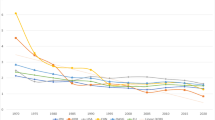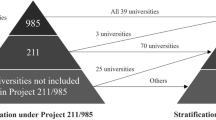Abstract
Little research examines the sociocultural aspects of consolidating two post-secondary educational institutions. In a previous study we collected baseline data and reported on the initial impact of consolidation of a research-oriented, health sciences university with a teaching-oriented, comprehensive university. In the study we report here we compared our baseline data with data collected two years after consolidation in order to explore the organization’s evolving culture and the effect of that evolution on faculty members, with a focus on faculty retention. We draw lessons about the impact of consolidation for policy makers considering this avenue for reorganization within public higher education.
Similar content being viewed by others
Notes
“Legacy institution” refers to the institution faculty affiliated with prior to consolidation.
In the second round some changes were made to the questions measuring research productivity, which is not a target of the discussion in this particular study. However the new productivity variables will be explored at a later date. In addition, as noted later in this paragraph, questions were added to enable us to include two additional control variables--race and gender--that were not used in the original study.
References
Allen, N. J., & Meyer, J. P. (1990). The measurement and antecedents of affective, continuance, and normative commitment to the organization. Journal of Occupational Psychology, 63, 1–18.
Alm, J., & Sjoquist, D. L. (2014). Georgia's post great recession revenue recovery. Atlanta, GA: Georgia State University, The Center for State and Local Finance. Retrieved from http://cslf.gsu.edu/files/2014/09/CSLF3_GA-Tax-Rev.pdf
Anseel, F., Lievens, F., Schollaert, E., & Choragwicka, B. (2010). Response rates in organizational science, 1995-2008: A meta-analytic review and guidelines for survey researchers. Journal of Business and Psychology, 25, 335–349.
Benton, A., & Austin, M. (2010). Managing nonprofit mergers: The challenges facing human service organizations. Administration in Social Work, 34, 458–479.
Bolman, L., & Deal, T. (1997). Reframing organizations (2nd ed.). San Francisco, CA: John Wiley & Sons.
Brown, A., & Humphreys, M. (2003). Epic and tragic tales: Making sense of change. The Journal of Applied Behavioral Science, 39, 121–144.
Cable, D. M., & Judge, T. A. (1996). Person-organization fit, job choice decisions, and organizational entry. Organizational Behavior and Human Decision Processes, 67, 294–311.
Caldwell, D. (2011). Bidirectional relationships between employee fit and organizational change. Journal of Change Management, 11, 401–419.
Cameron, K., & Quinn, R. (2011). Diagnosing and changing organizational culture. San Francisco, CA: John Wiley & Sons.
Choi, M. (2011). Employees’ attitudes towards organizational change: A literature review. Human Resource Management, 50, 479–500.
Clark, R. L., & Ma, J. E. (2005). Recruitment, retention and retirement in higher education: Building and managing the faculty of the future. Cheltenham, United Kingdom: Edward Elger.
Clinton, A. M. (2014). The role of higher education in innovation and entrepreneurship. New York, NY: Nova Science Publishers.
Cohen, G., Blake, R. S., & Goodman, D. (2016). Does turnover intention matter? Evaluating the usefulness of turnover intention rate as a predictor of actual turnover rate. Review of Public Personnel Administration, 36, 240–263.
Cora-Bramble, D., Joseph, J., Jain, S., Zhihuan, J. H., Gaughan-Chaplain, M., & Batshaw, M. (2006). A cross-cultural pediatric residency program merger. Academic Medicine, 81, 1108–1114.
Creasy, T., Stull, M., & Peck, S. (2009). Understanding employee-level dynamics within the merger and acquisition process. Journal of General Management, 35(2), 21–42.
Cunningham, C., Quan, H., Hemmelgarn, B., Noseworthy, T., & Beck, C. (2015). Exploring physician specialist response rates to web-based surveys. BMC Medical Research Methodology, 15, 1–8.
DaSilva, N., Hutcheson, J., & Wahl, G. D. (2010). Organizational strategy and employee outcomes: A person-organization fit perspective. The Journal of Psychology, 144, 145–161.
Fakunmoju, S., Woodruff, K., Kim, H. H., LeFevre, A., & Hong, M. (2010). Intention to leave a job: The role of individual factors, job tension, and supervisory support. Administration in Social Work, 34, 313–328.
Frew, D. R., & Bruning, N. S. (1987). Perceived organizational characteristics and personality measures as predictors of stress/strain in the workplace. Journal of Management, 13, 633–646.
Galpin, T., & Whittington, J. L. (2010). Merger repair: A conceptual framework for restoring employer/employee relationships. Journal of Behavioral and Applied Management, 12, 48–68.
Gardner, S. K., & Blackstone, A. (2013). Putting in your time: Faculty experiences in the process of promotion to professor. Innovative Higher Education, 38, 411-425.
Gordon, T. (2012). State and local budgets and the great recession. Washington, DC: Brookings Institute. Retrieved from http://www.brookings.edu/research/articles/2012/12/state-local-budgets-gordon
Harman, K. (2002). Merging divergent campus cultures into coherent educational communities: Challenges for higher education leaders. Higher Education, 44, 91–114.
Haunschild, P. R., Moreland, R. L., & Murrell, A. J. (1994). Sources of resistance to mergers between groups. Journal of Applied Social Psychology, 24, 1150–1178.
Holtom, B., Mitchell, T., Lee, T., & Eberly, M. (2008). Turnover and retention research: A glance at the past, a closer review of the present, and a venture into the future. The Academy of Management Annals, 2, 231–274.
Hoppes, C., & Holley, K. (2014). Organizational trust in times of challenge: The impact on faculty and administrators. Innovative Higher Education, 39, 201–216.
Kahn, R. L., Wolfe, D. M., Quinn, R. P., & Snoek, J. D. (1964). Organizational stress: Studies in role conflict and ambiguity. New York, NY: John Wiley.
Kezar, A., & Eckel, P. (2002a). The effect of institutional culture on change strategies in higher education. The Journal of Higher Education, 73, 435–460.
Kezar, A., & Eckel, P. (2002b). Examining the institutional transformation process: The importance of sensemaking, interrelated strategies, and balance. Research in Higher Education, 43, 295–328.
Locke, W. (2007). Higher education mergers: Integrating organizational cultures and developing appropriate management styles. Higher Education Quarterly, 61, 83–102.
Locke, E. A., Fitzpatrick, W., & White, F. M. (1983). Job satisfaction and role clarity among university and college faculty. The Review of Higher Education, 6, 343–365.
Manfreda, K., Bosnjak, M., Berelak, J., Haas, I., & Vehovar, V. (2008). Web surveys versus other survey modes: A meta-analysis comparing response rates. International Journal of Market Research, 50, 79–103.
McCoy, S., Newell, E., & Gardner, S. (2013). Seeking balance: The importance of environmental conditions in men and women faculty's well-being. Innovative Higher Education, 38, 309–322.
Mitchell, M., V. Palacios, & M. Leachman. (2014, May 1). States are still funding higher education below pre-recession levels. Washington, DC: Center on Budget and Policy Priorities. Retrieved from http://www.cbpp.org/sites/default/files/atoms/files/5-1-14sfp.pdf
Morris, L. V. (2005). Dramatic changes in faculty demographics. Innovative Higher Education, 30, 85–87.
Moynihan, D. P., & Pandey, S. (2007). The ties that bind: Social networks, person-organization values fit, and turnover intention. Journal of Public Administration Theory, 18, 205–227.
O’Reilly III, C. A., Chatman, J., & Caldwell, D. (1991). People and organizational culture: A profile comparison approach to assessing person-organization fit. The Academy of Management Journal, 34, 487–516.
Pick, D. (2003). Framing and frame shifting in a higher education merger. Tertiary Education and Management, 9, 299–316.
Ribando, S. J., & Evans, L. O. (2015). Change happens: Assessing the initial impact of a university consolidation on faculty. Public Personnel Management, 44(1), 99–119.
Schwab, D. P. (1991). Contextual variables in employee performance-turnover relationships. The Academy of Management Journal, 34, 966–975.
Slade, C. P., Ribando, S. J., & Fortner, C. K. (2016). Faculty research following merger: A job stress and social identity theory perspective. Scientometrics, 107(1), 71–89.
Stahl, G., Larsson, R., Kremershof, I., & Sitkin, S. (2011). Trust dynamics in acquisitions: A case study. Human Resource Management, 50, 575–603.
Staufenbiel, T., & König, C. J. (2010). A model for the effects of job insecurity on performance, turnover intention and absenteeism. Journal of Occupational and Organizational Psychology, 83, 101–117.
Xie, J. L. (1996). Karasek's model in the People's Republic of China: Effects of job demands, control, and individual differences. Academy of Management Journal, 39, 1594-1618.
Zhou, Y., & Volkwein, J. F. (2004). Examining the influences on faculty departure intentions: A comparison of tenured versus nontenured faculty at research universities using NSOPF-99. Research in Higher Education, 45, 139–176.
Author information
Authors and Affiliations
Corresponding author
Rights and permissions
About this article
Cite this article
Ribando, S.J., Slade, C.P. & Fortner, C.K. Once More into the Breach: Examining the Human Capital Impact of a University Consolidation over Time. Innov High Educ 42, 521–535 (2017). https://doi.org/10.1007/s10755-017-9404-0
Published:
Issue Date:
DOI: https://doi.org/10.1007/s10755-017-9404-0




